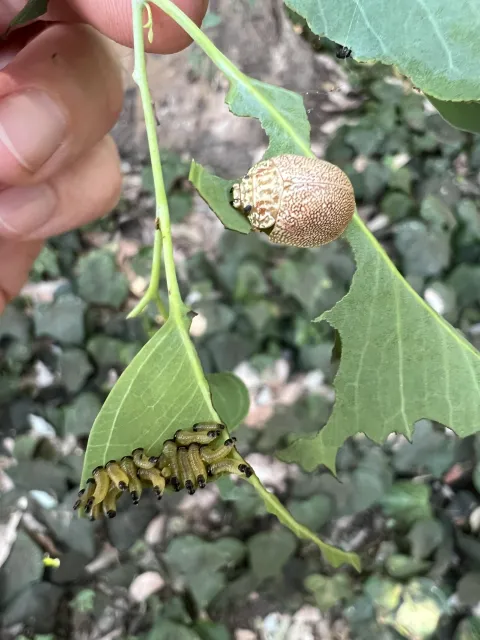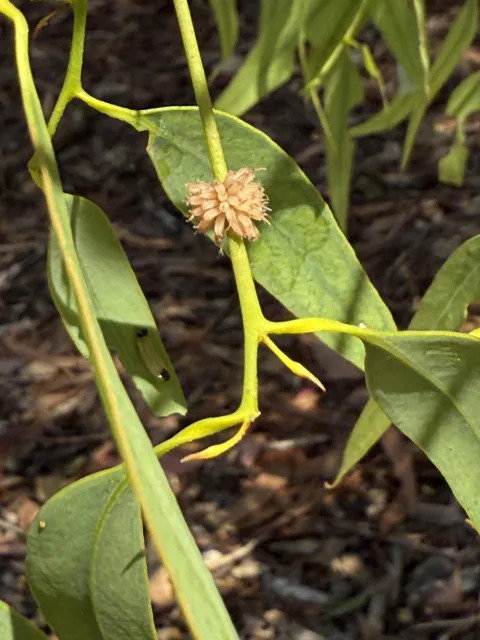The dotted paropsine leaf beetle (Paropsis atomaria), an invasive pest native to Australia, was first discovered in California in 2022 and is rapidly spreading throughout Southern California targeting eucalyptus trees. Both adult beetles and their larvae feed on eucalyptus leaves, causing significant defoliation that can result in tree death.
Brought (or “introduced) to California in the mid-1800s, eucalyptus trees are now an iconic part of California's landscape. When eucalyptus was first propagated from seed brought from Australia, the pests and diseases associated with living trees were not also introduced. Eucalyptus remained relatively pest free until the first major pest, the eucalyptus longhorned borer (Phoracantha semipunctata), was found in 1984. Since then, several major pests can now be found on eucalyptus, with the latest threat being the dotted paropsine leaf beetle. It is not clear how some of these pests came to California, but we do know that several can cause significant damage.
The dotted paropsine leaf beetle was first discovered feeding on lemon scented gum (Corymbia citriodora) in Los Angeles in August 2022. This was the first report of this beetle in North America and it has quickly spread throughout Southern California. Currently the beetle can be found throughout Los Angeles, Orange, San Diego, and San Bernadino counties with unconfirmed reports in Ventura County. The beetle has a broad host range, feeding on over 20 Eucalyptus and Corymbia species commonly found in California, including E. camaldulensis (red gum), E. globulus (blue gum), E. polyanthemos (silver dollar gum), E. cladocalyx (sugar gum), and C. citriodora (lemon-scented gum).

Identifying the Dotted Paropsine Leaf Beetle
The dotted paropsine leaf beetle is a member of the Chrysomelidae family, known as leaf-feeding beetles. Adult beetles are oval-shaped and are about 3/8 of an inch in size. They are easily identified by the yellow and orange markings, along with black spots on their wing case. Their bright coloring stands out against the green eucalyptus foliage making them easy to see.
Females lay 20-100 eggs in a circular cluster around young stems and leaves. When the larvae hatch, they are yellowish in color with black heads and black ends. As they mature through four larval instars, they develop black stripes along the top and sides of the body. Larvae have defensive glands on their rear ends and when threatened will discharge droplets. Mature larvae drop to the ground to pupate in the leaf litter.
In California, this beetle has two generations a year and can quickly build up in high numbers, leading to the rapid defoliation of susceptible Eucalyptus species, especially during peak feeding seasons in the spring and fall.

Other Eucalyptus Leaf-feeding Beetles in California
The introduction of the dotted paropsine leaf beetle is part of a larger trend of eucalyptus-feeding beetle introductions in California. Two notable examples include Trachymela sloanei and Chrysophtharta m-fuscum.
Eucalyptus Tortoise Beetle (Trachymela sloanei):
- Adults: Dark brown with blackish mottling
- Larvae: Dark green to reddish brown with a black head; feeds at night
- Damage: Feeds on eucalyptus foliage causing partial defoliation but is not as devastating as the dotted paropsine leaf beetle
Eucalyptus Leaf Beetle (Chrysophtharta m-fuscum):
- Adults: Gray to reddish brown
- Larvae: Light greenish gray with a black head; feeds during the day
- Damage: Primarily feeds on the leaves and stems causing extensive defoliation. Its feeding behavior is more aggressive than the eucalyptus tortoise beetle, and when left unchecked can defoliate entire branches
Dotted Paropsine Leaf Beetle Damage and Management
The dotted paropsine leaf beetle feeds primarily on the foliage of its host trees. Both adults and larvae cause damage by notching the leaves, which can quickly lead to stripping entire branches of their leaves. In severe infestations entire trees are defoliated, severely weakening the tree. Over time, repeated infestations can cause tree death, particularly in newly planted trees or those that are already stressed due to environmental conditions.
The beetles tend to congregate in high numbers, and during heavy infestations, it’s common to see multiple larval stages and adults clustering on different parts of the tree, as well as on the ground surrounding it.
Given the similarity between the eucalyptus leaf-feeding beetles, the management strategies will likely be similar for all. Strategies include a combination of cultural, biological, and chemical control methods. Read more on these other tortoise beetles on the UC IPM website: Pest Notes: Eucalyptus Tortoise Beetles.
Cultural Control
Provide proper horticultural care, such as appropriate irrigation, to maintain tree health. Prune out infested branches and remove fallen leaves that may contain beetle larva.
Biological Control
Currently there are no known natural enemies feeding on the beetle in California.
Chemical Control
Hire a professional for insecticide applications. Neonicotinoid soil drenches and foliar sprays of carbaryl may be effective, but these materials are not available for home use and can only be used by licensed applicators.
As with many invasive pests, preventing the spread of the dotted paropsine leaf beetle is crucial. To help contain the infestation, avoid transporting infested plant material. Monitor newly planted eucalyptus trees for signs of beetle damage and inspect trees regularly to catch infestations early. The dotted paropsine leaf beetle is just one of several eucalyptus pests introduced to California, which together require a coordinated and comprehensive pest management approach.
[Originally featured in the May 2025 issue of the Home and Garden Pest Newsletter]

